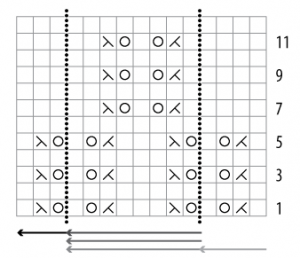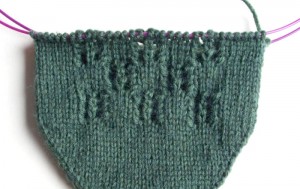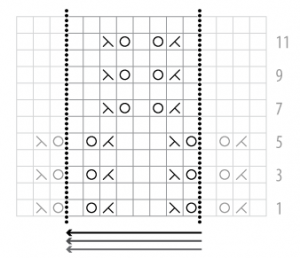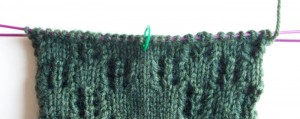Avoiding hiccups
By JC | June 11, 2010
For the past couple weeks, I’ve been adding illustrations to Charts Made Simple. The goal has been to get the manuscript ready for review next week: four friends have graciously agreed to look at this early draft, and tell me where it still needs work. Having that deadline has, understandably, lit a much-needed fire under my butt.
Most of these newly-created illustrations have been photos of swatches, which is another way of saying I’ve been sitting around knitting during the day. (That has felt tremendously weird, as I normally let myself knit in the evening as a “reward” for having done “real” work during the day.) For one set of photos, though, I felt compelled to knit an entire sock, taking WIP photos along the way.
Charts Made Simple uses these WIP photos to illustrate a series of points related to repeated stitch patterns. Take this chart, for example:
Knitters familiar with charts can probably guess that the dotted lines are “repeat lines.” Like the * or [ ] of written instructions, they surround the stitches that get worked multiple times. The stitches outside the repeat lines are “edge” stitches that let the stitch pattern appear balanced left and right. They get worked only once per row. That is, for each row of the chart, work the edge stitches at the first edge once, repeat the stitches between the dotted lines as many times as necessary for the width of your piece, then end by working the edge stitches at the second edge just once.
But what if you’re working in the round? Ah, that’s where our sample sock comes in.
When you’re working a repeated stitch pattern over just a portion of a round—such as the instep (but not the sole) of a sock foot—then you want to follow the chart as when working flat, working the edge stitches once per round.
But when working a repeated pattern all the way around a piece—such as a sock leg—omit the edge stitches. Just work the repeated stitches.
After all, a round of knitting is a circle, and a circle doesn’t have beginning or ending edges, now does it? So the edge stitches aren’t necessary.
Here’s the kicker: if you goof, and work unnecessary edge stitches, you’ll get a “hiccup” in your patterning:
So, this is the sort of stuff that Charts Made Simple is all about. Pictures being worth a thousand words, you can probably see why I’ve been knitting so many samples.
And this sample sock? Will it turn into a pair? Probably. Even though I just threw it together to illustrate some points, without my usual swatching and scheming and planning, it’s pretty comfy. Not terribly pretty, though. I’m tempted to tweak the design a little—I have some ideas tugging at me—and re-knit it in a more colorful yarn.
We’ll see. Charts Made Simple is still tops on my to-do list.









3 Comments